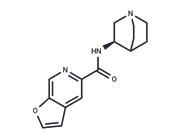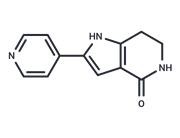| Name | PHA-767491 hydrochloride |
| Description | PHA-767491 hydrochloride (CAY-10572 hydrochloride) is an effective ATP-competitive dual Cdc7/CDK9 inhibitor (IC50: 10/34 nM). It has ~20-fold selectivity against GSK3-β and CDK1/2, 50-fold selectivity against CDK5 and MK2, 100-fold selectivity against CHK2 and PLK1. |
| Cell Research | For assays in 96 well plates 2500 cells are plated per well. After 24 hours, cells are treated with small molecule inhibitors and incubated for 72 hours at 37°C. Subsequently the cells are lysed and the ATP content is measured as an indicator of metabolically active cells using the CellTiter-Glo assay. IC50 values are calculated using the GraphPad software. For assays in six-well plates, 100,000 cells are plated per well. After 24 hours, cells are treated with small molecule inhibitors and incubated for varying time points. Cells are trypsinized and a suspension is made in 5 mL of phosphate buffered saline. 30 μL of this suspension is mixed with 30 μL of CellTiter-Glo reagent followed by a 10-minute incubation at room temperature. Luminescence is measured using EnVision 2104 Multilabel Reader and BioTek Synergy Neo Microplate Reader. |
| Kinase Assay | 20 ng of purified human DDK is pre-incubated with increasing concentrations of each DDK inhibitor for 5 min. Then 10 μCi (γ)-32P ATP and 1.5 μM cold ATP are added in a buffer containing 50 mM Tris-HCl (pH 7.5), 10 mM MgCl2, and 1 mM DTT and incubated for 30 min at 30°C. The proteins are denatured in 1X Laemmli buffer at 100°C followed by SDS-PAGE and autoradiography on HyBlot CL film. Auto-phosphorylation of DDK is used as an indicator of its kinase activity. 32P-labeled bands are quantified using ImageJ and the IC50 values are calculated using GraphPad. |
| In vitro | PHA-767491 inhibits proliferation of HCC1954 cells (IC50: 0.64 μM) and Colo-205 cells (IC50: 1.3 μM). PHA-767491 is effective DDK inhibitors in vitro (IC50: 18.6 nM). PHA-767491 (2 μM) completely abolishes Mcm2 phosphorylation by 24 hours in HCC1954 cells [1]. PHA-767491 in combination with 5-FU exhibits much stronger cytotoxicity and induces significant apoptosis manifested by remarkably increased caspase 3 activation and poly(ADP-Ribose) polymerase fragmentation in HCC cells. PHA-767491 directly counteracts the 5-FU-induced phosphorylation of Chk1 and decreases the expression of the anti-apoptotic protein myeloid leukemia cell line [2]. PHA-767491 (0-10 μM) time- and dose-dependently decreases glioblastoma cell viability (IC50: about 2.5 μM) for U87-MG and U251-MG cells. |
| In vivo | PHA-767491 decreases Chk1 phosphorylation and enhances apoptosis directly within sections of tumor tissues from HCC xenografts in nude mice. |
| Storage | Powder: -20°C for 3 years | In solvent: -80°C for 1 year | Shipping with blue ice. |
| Solubility Information | H2O : 25 mg/mL (100.12 mM), Sonication is recommended.
DMSO : 4.62 mg/mL (18.48 mM), Sonication is recommended.
|
| Keywords | PHA-767491 Hydrochloride | PHA-767491 | PHA767491 | PHA 767491 | GSK-3β | GSK3 | Cdk9 | Cdk2 | Cdk1 | CDK | Cdc7 | CAY10572 Hydrochloride | CAY-10572 | CAY10572 | CAY 10572 Hydrochloride | CAY 10572 | Apoptosis |
| Inhibitors Related | Stavudine | 5-Fluorouracil | Flubendazole | Cysteamine hydrochloride | Myricetin | Dextran sulfate sodium salt (MW 4500-5500) | Sodium 4-phenylbutyrate | L-Ascorbic acid | L-Glutamic acid | Tributyrin | L-Ascorbic acid sodium salt | Alginic acid |
| Related Compound Libraries | Anti-Neurodegenerative Disease Compound Library | Bioactive Compound Library | Membrane Protein-targeted Compound Library | Kinase Inhibitor Library | Anti-Cancer Clinical Compound Library | Drug Repurposing Compound Library | Neuroprotective Compound Library | Anti-Aging Compound Library | Immunology/Inflammation Compound Library | Bioactive Compounds Library Max | Anti-Cancer Active Compound Library | Anti-Cancer Drug Library |

 United States
United States



